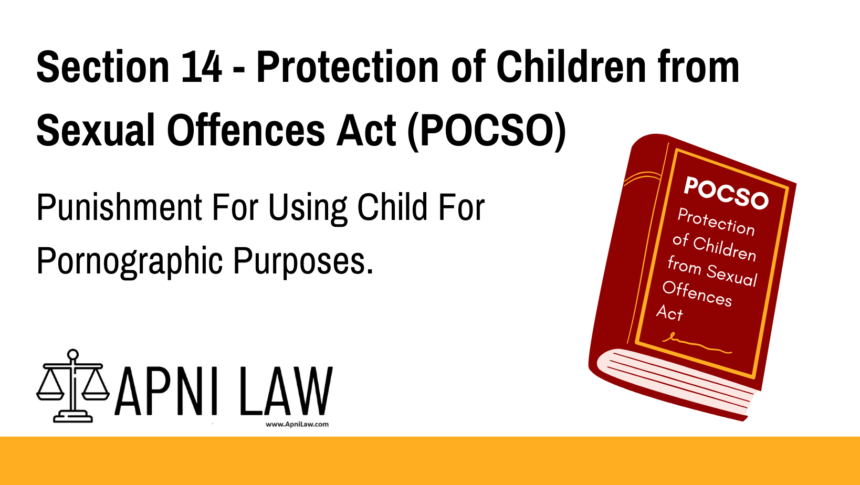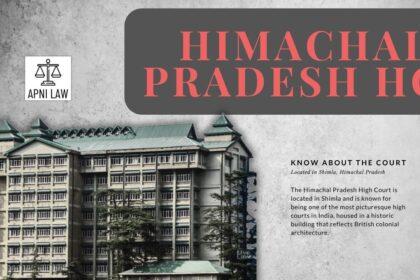Code: Section 14 POCSO Act
(1) Whoever uses a child or children for pornographic purposes shall be punished with imprisonment for a term which shall not be less than five years and shall also be liable to fine and in the event of second or subsequent conviction with imprisonment for a term which shall not be less than seven years and also be liable to fine.
(2) Whoever using a child or children for pornographic purposes under sub-section (1), commits an offence referred to in section 3 or section 5 or section 7 or section 9 by directly participating in such pornographic acts, shall be punished for the said offences also under section 4, section 6, section 8 and section 10, respectively, in addition to the punishment provided in sub-section (1).
Explanation of Section 14 POCSO
Section 14 of the Protection of Children from Sexual Offences Act, 2012, lays down the punishment for individuals who are found guilty of using children for pornographic purposes, as defined in Section 13 of the Act.
This provision not only criminalizes the use of children in pornographic material but also enhances the punishment significantly—especially for repeat offenders. Importantly, it ensures that if the person creating such content also participates in sexually exploitative acts with the child, they will be charged and punished under the appropriate aggravated sexual offense provisions as well.
Key Highlights:
- Minimum 5 years of imprisonment for first-time offenders.
- Minimum 7 years of imprisonment for repeat offenders.
- Additional charges and punishment apply if the offender also commits sexual assault or aggravated sexual assault in the process.
Key Provisions
- Minimum imprisonment of 5 years for using a child in pornographic content.
- On second or subsequent conviction, minimum imprisonment is increased to 7 years.
- If the accused also commits:
- Penetrative sexual assault (Section 3) – punished under Section 4.
- Aggravated penetrative sexual assault (Section 5) – punished under Section 6.
- Sexual assault (Section 7) – punished under Section 8.
- Aggravated sexual assault (Section 9) – punished under Section 10.
- The punishment under this section is in addition to the punishment for these offenses.
Illustration
Example 1: First-Time Offense
A person is found guilty of using a 14-year-old child in a pornographic video. Even if no physical assault is committed, they are liable under Section 14(1) and face a minimum of 5 years in prison and a fine.
Example 2: Offense with Aggravated Sexual Assault
A man records himself performing a sexual act with a child and shares the video online. Since this includes both using the child for pornography and committing aggravated penetrative sexual assault (Section 5), he is liable under both Section 14(1) and Section 6.
Common Questions & Answers
1. What is the punishment for a first-time offense under Section 14?
The minimum punishment is 5 years of imprisonment and a fine.
2. What happens in case of a second or subsequent conviction?
The offender shall be punished with a minimum of 7 years imprisonment and fine.
3. Can someone be punished under other sections in addition to Section 14?
Yes. If the offender also commits a sexual assault under Sections 3, 5, 7, or 9, they will be additionally punished under Sections 4, 6, 8, or 10 respectively.
4. Does Section 14 require physical participation in the act?
No. Even facilitating or using a child in pornographic material is punishable. However, if the offender directly engages in the act, the law imposes additional and more severe punishments.
5. Is bail available for this offense?
Given the seriousness and the minimum sentence involved, the court exercises strict discretion in granting bail for such offenses.
Conclusion
Section 14 of the POCSO Act enforces strict penalties against those who exploit children for pornographic purposes. The law is crafted to ensure that not only are such exploiters punished, but those who also commit physical abuse as part of these acts face even harsher consequences. With clear minimum sentences and provisions for multiple convictions, this section plays a critical role in deterring crimes against children.
For comprehensive legal explanations and expert insights into child protection laws, visit ApniLaw.








